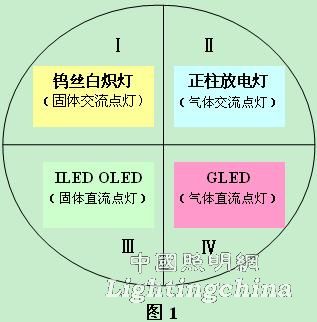Introducing a new lighting product, GLED (Gas Light Emitting Diode), which has a unique wick structure and working mechanism. Analyze the technical advantages and market prospects of GLED by comparing with the performance of existing electric light sources.
Keywords GLED technology advantage market prospect
1. Deduction of electric light source
In the public impression, the symbol of energy utilization is the electric light. In the global energy-saving movement, the lighting industry has to share this burden. Many governments have introduced a policy prohibiting the use of tungsten incandescent lamps. Manufacturers of incandescent lamps are facing bankruptcy; LEDs are known as "the final form of lights", and the energy-saving lamps that are currently being watched may not be good for a long time; the current status of lighting sources is so bleak. ?
Looking at the current status of electric light sources, it can be roughly illustrated in Figure 1. In Figure 1: I block tungsten incandescent lamp (solid AC lamp), II block discharge lamp (gas AC lamp), III ILED and OLED (solid DC lamp) have been produced and used; and IV block GLED (Gas DC lamps) have just been developed.

Listen to the motto of Witness: "There is always a 'but' in the development of the science and craft of lamps." At present, the more commonly used I, II, and III electric light sources in Fig. 1 are more or less "but" in terms of price or energy saving or life. Obviously, all light sources have their mission to develop regeneration; all light sources cannot be considered a "final form."
Although the government prohibits the use of tungsten incandescent lamps, people always want to use other electric light sources like incandescent lamps. This has led to the pattern of straight tube fluorescent lamps made of H, U, spiral, etc. On the other hand, small discharge lamps with the appearance of incandescent lamps have been produced; in recent years, many countries have also studied the use of carbon nanotubes as cold cathodes. The new vacuum fluorescent light source, FED Fluorescent Tube; GLED---Gas light-emitting diode is also developed to meet this demand.
2. Arc discharge ball
The working area of ​​the positive column discharge lamp is indispensable to the dark and dark areas of the Faraday dark area, the Asden dark area, the cathode area, etc. The GLED uses two modes of positive and negative discharges, which are different from the positive column discharge. First, a series of bright and dark areas unique to the discharge of the positive column are gone, replaced by an integrated arc discharge. The inventor discovered the integrated arc discharge ball in the GLED alone in the test, and proposed the e-discharge theory. In the document disclosed in CN101110338A, only the electrons coming out of the hot spot are mentioned. Due to the action of the non-uniform electric field, the velocity direction of most electrons does not point to the anode rod, they will follow the parabolic track: the space is exposed to the anode rod. The acceleration of the crucible is decelerated by the electric raft in the space away from the anode rod, and as a result, the reciprocating vibration is reciprocated around the anode rod. This is a brief explanation based on people's existing cognitive foundations; in fact, even though electrons are so represented in GLEDs, all charged particles have such vibrations in GLEDs due to the action of non-uniform electric fields. For example, after obtaining the initial momentum, the mercury ion will focus on the elliptical orbit with the cathode hot spot as the focus: the space toward the cathode hot spot is accelerated by the electric enthalpy, and the space away from the cathode hot spot is decelerated by the electric enthalpy, and the result will also be made around the cathode hot spot. Reciprocating vibrations back and forth.